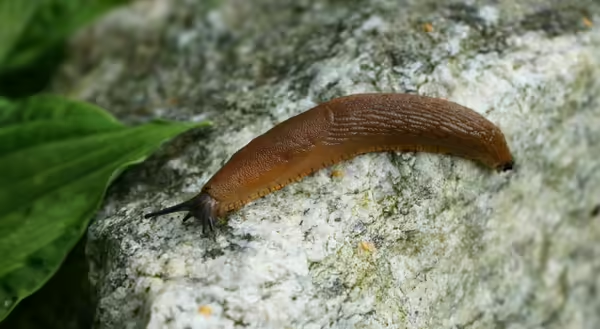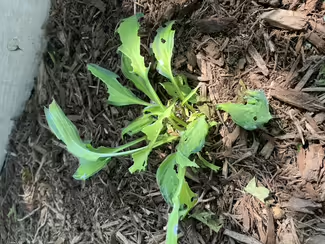
If you have noticed ragged, irregular holes in your hostas or other broad-leaf garden plants, you may be dealing with garden slugs. These soft-bodied pests can be found in shady, moist gardens, and although small, they can cause significant damage.
Identifying Slugs
Slugs are members of the mollusk family, closely related to snails, oysters, and clams but lacking the protective shell. Adults grow to approximately two inches in length. They are typically gray to brown in color and lack legs. Slugs move by gliding on a muscular foot aided by a mucus secretion that reduces friction and prevents desiccation. Their heads feature two feelers. The larger set of feelers contains eyes for vision and helps with smell. The smaller set of feelers is used for touch and taste.
Slugs feed mostly at night or during days with cloud cover and moisture. Using specialized mouthparts called radula, slugs chew large, irregular holes in leaves, often avoiding tough veins and the midrib. Feeding may also occur on flowers and fruit. Damage can be extensive, sometimes consuming entire seedlings. Plants located in the shade or near the ground are particularly susceptible. In addition to seeing damage from feeding, slime trails may be visible on leaves, mulch, or nearby walkways as evidence of slug populations.
Control Methods
A combination approach is recommended to control slugs in the garden. Utilizing cultural, physical, and, when necessary, chemical methods can help reduce slug populations and damage.
Slugs thrive in damp environments and require protection from dehydration. During drying days, slugs will seek cover in cool, shaded areas such as under leaf piles, mulch, ground cover plants, stepping stones, decks, and more. Minimize hiding areas or create similar conditions to attract slugs to a designated area as a trap, and check the trap daily. Dispose of slugs found in traps or on plants in soapy water or crush them.
A beer or yeast water trap can be used in the garden to drown slugs. A container is buried in the ground, so the top is level with the soil surface. Fill the container with five to six inches of beer or a water-yeast mixture, leaving at least one inch of space below the top of the container. Slugs are attracted to the odor and drown when trying to obtain a drink. Check the traps multiple times each week, clean and refill as needed.
Copper, when encountered by the mucus covering of slugs, creates a mild electrical shock. This is assumed to be unpleasant and deters slugs from crossing. Surrounding plants with real copper tape or flashing protects plants from damage, but it does not kill the slug. For best results, copper flashing needs to be wide enough to fit the entire slug and kept clean and dry. Used alone, copper is unlikely to provide effective control, but can be incorporated into a system.
Diatomaceous earth can also be used as a barrier around plants. Diatomaceous earth is made from fossilized aquatic creatures called diatoms. When used as a powder around plants and encountered by slugs, it causes the slug to dry out and die. Additionally, the diatomaceous earth particles have sharp edges that create many small abrasions on the foot of the slug that aid in desiccation.
Chemical options include iron phosphate and ferric sodium EDTA. These pesticides are poisonous to slugs when consumed. Literature suggests that these chemical treatments do not pose a significant risk to children or pets, although some risks persist. Use with caution, and whenever utilizing a chemical in the home landscape, it is essential to read and follow pesticide labels thoroughly.
Conclusion
Slugs are persistent and often frustrating home landscape pests, especially in shady, moist areas. Although damage can be unsightly and sometimes severe, consistent monitoring and an integrated pest management system can help successfully manage slug populations and minimize impact.
Good Growing Fact of the Week: Slugs need to maintain body moisture; therefore, cultivating a sun garden can help minimize impact. Choose plant species that tolerate full sun and drier soil conditions to maximize this strategy.
Thank you for reading!
Sign up for our emails! Want to get notified when new Good Growing posts are available? SIGN ME UP
Give us feedback! How helpful was this information (click one): Very helpful | Somewhat helpful | Not very helpful
MEET THE AUTHOR
Emily Swihart is a horticulture educator with University of Illinois Extension, serving Henry, Mercer, Rock Island, and Stark counties since 2021. Emily provides horticulture programming with an emphasis on the home gardener, the urban forest, native plant ecosystems, and landscape design. Additional responsibilities include supporting local county Master Gardener and Master Naturalist volunteers - providing training, continuing education, advanced training, and their involvement in seasonal events and community outreach programs.

